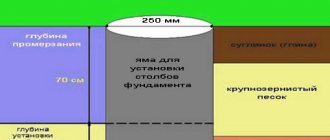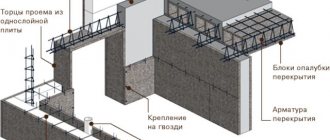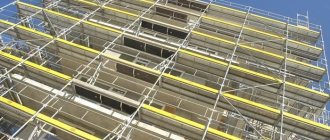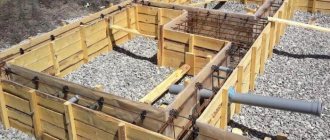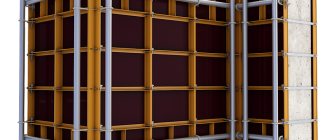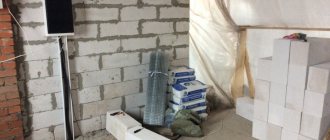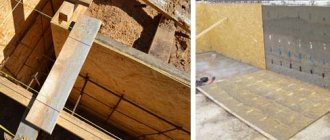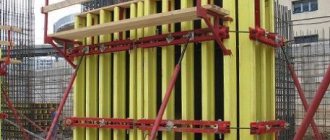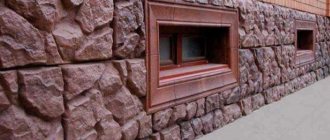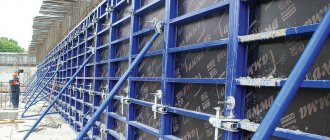Concrete columns are load-bearing structures that provide vertical rigidity to buildings. The type of column can be monolithic or metal, the choice of which depends on the required load-bearing capacity. The purpose of the columns is to serve as a support for the upper floors, balconies, terraces and other elements of buildings. It is possible to make concrete columns with your own hands; these can be ordinary elements from a square pipe or more original beautiful designs that can add zest to the appearance of buildings.
Kinds
Concrete columns have the following types:
square; round; rectangular.
When working with various types of concrete columns, the following types of production technology are distinguished:
Prefabricated supports are structures manufactured in factories that are transported to the work site where they are installed. Prefabricated columns have the following advantages: relatively low price, speed of installation, quick drying of the solution. Monolithic. Pouring into molds is carried out at the construction site. When working with monolithic columns, the following advantages are distinguished: the ability to monitor the quality of laying the concrete solution, the absence of leakage of the mixture. Among the disadvantages observed: a long time for production, waiting for the mixture to harden in the mold. Return to contents
Principle of operation
The operating principle of a stripping column can be considered using the example of a stripping column in a hydrotreating unit. The raw material is an unstable hydrogenate after RB hydrotreating, which has passed through a separator to remove VSG from the gas product mixture.
Stripping column of the hydrotreating unit
The unstable hydrogenated product passes through the annulus of the T‑1 , heating up due to the heat of the withdrawn bottoms product. K-1 column as food . The column uses valve-type trays.
To supply the required amount of heat to the column, a P-1 . Part of the product from the bottom of the column is fed in parallel streams into the furnace, where it is heated by burning liquid or gaseous fuel.
At the outlet of the furnace, the streams are combined and enter the column. The bottom product of the K-1 is a stable hydrogenate, which is removed from the column under pressure and goes for further processing, depending on the type of installation.
The balance amount of stable hydrogenate from the column bottom enters the tube space of the T-1 , where it gives up its heat to the unstable hydrogenate - the raw material of the stripping column.
the K-1 stripping column, the upper product is removed - hydrocarbon vapors, water, ammonia, hydrogen and hydrogen sulfide. After cooling and condensation in the air refrigerator-condenser XB-1 and the water refrigerator X-1, the upper product enters the irrigation tank E-1 .
In the reflux tank of the stripping column, hydrocarbon gas is separated from the liquid phase, the liquid phase is separated into a hydrocarbon phase (liquefied petroleum gas or overhead fraction) and acidic water. Part of the liquefied gas from tank E-1 by pump N-2 as reflux to the stripping column K-1 . The balance amount of LPG from the discharge of the N-2 is removed from the installation and sent to the gas fractionation installation. Gas from tank E-1 is removed to the desulfurization unit.
By the way, read this article too: Cross Flow Nozzles (CFC)
Installation Features
You must remember to follow the installation rules.
Square supports are installed at the edges of the corners of buildings and structures, secured with anchors to the ceiling and base of the structure. However, it is worth noting that installing a square pipe with your own hands is a labor-intensive and complex process, so experienced builders do not recommend installing this type of column with your own hands. Supporting structures can be in the form of a small brick wall. Supports made of wood or logs are installed on porches or verandas.
When installing a supporting element into a concrete base, steel glasses are first secured with anchors, and then the support is installed and concreted. Supporting structures located in the center of the structure play a great importance in the construction of houses. In this case, column supports with a calculated cross-section of metal reinforcement are used, followed by pouring concrete and installing formwork.
Do-it-yourself concreting of column elements is an important undertaking that should be carried out responsibly and with a certain amount of knowledge and skills in performing the work. Concreting into forms is carried out continuously, maintaining a horizontal position, which will help avoid the formation of intermediate cold joints and protect the structure from destruction.
Return to contents
Disposable cardboard formwork for columns and bored piles
With the monolithic method of constructing buildings according to individual projects, the use of wooden, and even more so, aluminum formwork is not economically feasible. Even despite the good quality of the final surface, the complexity of its configuration does not make it possible to fully realize the benefits of reusable formwork. What can we say about round surfaces, and of various diameters! In such cases, the only way out is disposable cardboard formwork.
Construction stages
The construction of concrete supports consists of the following stages:
before starting work, prepare the necessary tools and materials; clean the surface of construction debris; begin installing the formwork; carry out reinforcement work; then pour the concrete solution and, after it dries, dismantle the formwork.
The concrete mixture must have a plastic consistency and be durable after hardening. The strength of the structure is influenced by the components of the concrete solution and the technical characteristics of the reinforcement, which must have the following properties:
strength; ease of welding; low possibility of corrosion on the product; good adhesion. Return to contents
Currently reading: Ships made of concrete
Advantages of using disposable formwork
Cardboard formwork for pillars has many advantages that facilitate construction and reduce its cost:
- Easy to install and dismantle, not requiring the use of lifting equipment. The formwork is assembled according to height and secured with the help of crowns. Removal of the sleeve is carried out by dismantling the complete stripping cord.
- Surface cleanliness - due to the absence of seams, the cast element has a smooth surface and is completely ready for finishing.
- Strength – the formwork system, thanks to its multilayer structure, has maximum rigidity, is resistant to deformation loads and does not lose shape under the heavy weight of the concrete solution.
- Waterproof - the design does not absorb water, maintaining its shape for a long time. This allows it not to be dismantled until the construction process is complete.
- Cost – the price of disposable formwork is 15-20 times lower than traditional systems, which makes construction more profitable.
Used disposable column formwork does not require special disposal means and can be removed from the work site along with other construction waste.
Installation of formwork
The formwork is fastened, maintaining the strength and reliability of the structure. The form is installed on four sides of the support using wooden spacers. If the column is high, the formwork is secured on three sides, and the fourth side is expanded when poured with concrete. When installing the form, ensure the evenness of the structure, which is checked with a building level. The leveled formwork is secured with screws, which hold the concrete mixture inside the product. Next, check the correspondence of the corners with a rectangular corner.
Return to contents
What is cardboard column formwork?
Formwork systems have a multi-layer structure. Each layer has its own characteristics of strength and resistance to various loads and moisture. High-quality disposable formwork for round columns, produced using innovative technologies, can consist of layers of polyethylene of various densities, aluminum foil and kraft paper. It is also made using reinforced adhesives and auxiliary materials. Different manufacturers use their own methods and materials for the production of cardboard formwork for columns, the price and weight of which will directly depend on them.
The materials used are layered on top of each other using the technology of dense winding on a shaft, heating or gluing. Temperature and adhesive composition contribute to high-quality “sintering” of the layers. Result: cardboard formwork for columns acquires a monolithic structure. At the same time, the spiral layering method and the use of materials of different tensile strength give it high resistance to loads.
Therefore, multilayer formwork for round columns is a disposable, reliable system that allows for simple installation/dismantling. The production technologies used also provide the system with a number of other advantages:
- low weight of the forming structure;
- availability of disposable cardboard formwork for columns and columnar foundations - the price of forming elements in our company will range from 1,030 to 2,500 rubles;
- savings on the use of special equipment;
- simple movement of disposable formwork around the construction site;
- optimal height - disposable formwork for round columns, the price of which will depend on the diameter of the product, can have dimensions of 0.5-12 m. The elements allow you to increase the height to 30 m;
- concrete load resistance up to 60 kN/m2 inclusive;
- if necessary, cardboard formwork, the price of which will depend on the type of section, is made individually for any type of profile: antique columns, decorative, elongated, oval, etc.;
- reduction of construction time by 67%;
- does not complicate dismantling - cardboard formwork for round columns and objects of non-standard cross-section does not stick to concrete;
- does not require maintenance or special storage - disposable round column formwork (mono-tube, petri or TVT) can be stored in a warehouse in a vertical or horizontal position;
- quick and easy disposal;
- high resistance to moisture and temperatures.
Our catalog presents disposable monotube formwork for round columns at manufacturer's price, forming systems TVT, petri and others. We will organize prompt delivery of goods to the construction site and help you make a choice.
Reinforcement
When installing a column, vertical reinforcements are used, the diameter of which is about 1.2 centimeters or more. The vertical reinforcement consists of four rods, which are located at the corners of a square shape. To facilitate the installation of fittings whose height is more than three meters, decking is installed in increments of two meters.
The support frame is assembled using various methods. Having small dimensions, weight and volume of the supporting structure, the frame is mounted into the future formwork form, doing the work with your own hands by turning the finished frame. If the reinforcement is heavy, its base is pre-assembled and the rods are tied together at the work site, where individual rods are installed. When placing the finished structure, a variety of boards and supports are used. The reinforcement bars are fastened to each other using metal wire, maintaining a distance of about forty centimeters.
Return to contents
Purpose of concrete columns
The element takes on and transfers to the foundation the load from higher structural parts. become the support of the floors, connecting the structure between the base and the ceiling surface. The pillar supports a variety of terraces, balconies, porches, ceilings, making it possible to implement any design idea and significantly increasing the service life of the entire building.
If we are talking about decorative design, then in this case concreting columns acts as a means of decorating the facade and interior. They are often made with column sills, consoles, capitals, decorated with stucco molding, original patterns, and various types of material processing.
Concreting
Column concreting scheme.
When starting to lay the concrete mixture, pay attention to the characteristics of the concrete. This composition has mobility, which plays a big role when concreting columns. Movable concrete is easy to place and does not require compaction with vibrators or concrete pumps during the work process. Concreting occurs in even layers in a horizontal position. When laying the mixture, it is periodically compacted with metal rods.
If necessary, compact the solution. You can’t do without a deep vibrator. Remove air bubbles from the concrete by tapping the formwork with a hammer. When concreting the columns, the reinforcement frame is periodically aligned in the center. To lay the mortar, choose cement, which is part of concrete grade M400, of which one part is required; also, to prepare the mixture, take two parts of sand and two parts of gravel and crushed stone. Dry ingredients are poured with water in the required volume until a homogeneous thick consistency is obtained. At the end of the process of laying the prepared concrete mixture, they begin to install the reinforcement, which is fixed with anchors.
The laid concrete is left to dry in a place with optimal temperature and humidity conditions. The surface of the concrete is periodically irrigated with water and, if necessary, covered with plastic film to avoid exposure of the mixture to precipitation and direct sunlight.
Return to contents
Classification
Stripping columns, depending on their area of application, may differ in both technological design and contact devices.
In industry, liquid and vapor streams in a stripping column may have the following streams:
- Parallel
- Countercurrent
Type of contact devices
Based on the type of contact devices, columns can be divided into the following categories:
- dish columns
- packed columns
- spray columns
From left to right: packed column, tray column, spray column.
Stripping is most often carried out in tray and packed columns and less commonly in atomizer columns, bubble columns and centrifugal extractors.
Tray columns are a vertical apparatus in which the liquid phase flows down the column from top to bottom and is discharged from the bottom. The vapor phase enters the bottom of the column and leaves the top. There are plates inside the column. The liquid phase moves horizontally across the tray and flows down, while the vapor rises up through the holes in the trays. The purpose of the plates is to increase the contact area between the liquid and vapor phases.
By the way, read this article too: Rectification gases
Packed columns are similar to tray columns in that the liquid and vapor streams enter and exit the column in the same manner. The difference is that packed columns do not have trays. However, the nozzle is used to increase the contact area between the vapor and liquid phases. There are many different types of attachments, and each has its own advantages and disadvantages.
Technological design (“hot steam”)
According to the type of technological design, there are the following types of stripping columns:
- With the supply of “hot” steam to the cube of the column (columns of the “stripping” type)
When fractionating oil and oil residues, a large number of distillates are obtained. For such separation, a multi-column system is used. Complex AVT columns are divided into the following types: vacuum columns, stripping columns. In stripping columns, light fractions are stripped with water vapor. Structurally, stripping columns can be placed inside distillation columns or as independent columns.
Remote stripping columns can be single-section or multi-section. The side distillate flows to the upper plate of the corresponding stripper. Depending on the required clarity of the vertical separation, the remote columns have from 4 to 8 trays. The side straps are removed from the “blind” plates in the main column. Each stream is usually equipped with a corresponding pump. When withdrawn from the column, the product is in equilibrium with the steam rising through the holes in the tray valves. Consequently, the liquid product will contain a portion of light hydrocarbons, which will affect the required product properties such as flash point and ASTM distillation. To correct this, the side stream is steam stripped in a separate tray stripper column. This arrangement is shown in the figure.
Scheme of operation of a side stripping column
Such stripping columns are widely used in automatic cracking and catalytic cracking installations when separating kerosene and diesel fuel fractions in a rectification column.
The operating pressure of the stripping column can affect the efficiency and reliability of the column. At lower operating pressures, greater volatility and lower operating temperatures are achieved. Jet columns operating under vacuum can be expensive but highly efficient; they allow the use of plastic internals to combat the effects of aggressive systems. Operating the column at or near atmospheric pressure results in increased volatility and lower operating temperatures without the added expense of a vacuum system. At higher operating pressures, the solubility of the solute increases and separation becomes more difficult to achieve. Additionally, at higher pressures, more steam is required to be supplied to the column for the same separation to occur.
By the way, read this article too: Packed and plate column devices
Also, the supply of hot water steam to the bottom of the stripping column is widely used in the purification of wastewater from organic compounds.
- Without supplying “hot” steam to the column cube
Such columns are used in oil refining to remove ammonia, hydrogen sulfide, water and other compounds obtained as a result of the hydrotreating process, which are catalytic poisons for various catalysts.
Stripping columns are also used to extract absorbed gases from a saturated absorbent in absorption processes. This is why the stripping process is often called the “desorption” process.
According to the method of heat supply and removal
Stripping columns may differ from each other in the way heat is supplied to the bottom of the column. These may be options for organizing heating through a reboiler, a reboiler furnace, with the supply of “hot” steam to the bottom of the column.
To maintain the thermal balance of the column, heat must be removed from the top of the column. There are different options here too. There are schemes with condensation of vapors and supply of irrigation to the upper plate of the column, as in the described scheme of the column of the hydrotreating unit. stripping columns , vapor condensation is not provided; vapors from the top of the column are sent to the main distillation column.
Dismantling of formwork
After the concrete solution has hardened and achieved its maximum strength characteristics, they begin to dismantle the formwork. Removal of formwork is entrusted to qualified workers. Dismantling begins with removing the side parts of the formwork, which do not bear the load on the structure. It is important to dismantle the formwork after ensuring the strength of the concrete, which is established by building codes. The strength of the concrete solution is determined in the laboratory by conducting trial tests of samples of the material. Stripping is carried out in a strict sequence, ensuring the safety of structural elements.
Return to contents
Types of formwork systems for columns and foundations
Both removable and permanent formwork for columns can be used on a construction site, the price of which will depend on the type of structure. Moreover, it can be either disposable or reusable. The second type of cardboard formwork for round columns, the price of which will be slightly higher, can be used up to 10 times. The strength and load resistance of the formwork system is determined by the thickness of the walls of the object. It can vary from 7 to 30 mm. The catalog also presents cardboard formwork for columns with square and rectangular cross-sections with foamed polystyrene.
Also, formwork for round columns, disposable and reusable, differs in the characteristics of the internal surface:
- standard flat surface;
- spiral-shaped clear pattern - its presence on the inside of the disposable column formwork does not affect the simple dismantling of the structure;
- imitation marble surface;
- perfectly smooth pipe;
- beveled corners, etc.
If you plan to store cardboard formwork for round columns or objects of non-standard cross-section in a warehouse, then it is wiser to order folding formwork structures. They are presented in a wide range in our catalog. The disposable cardboard formwork for columns ordered from our company will correspond to the characteristics declared by the manufacturer. We guarantee excellent quality of the products offered.

